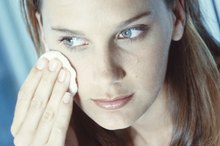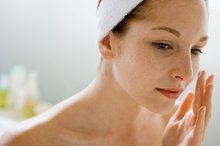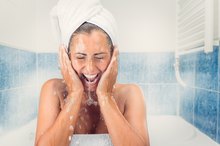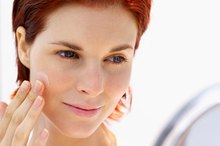What Are the Side Effects of Alpha Hydroxy Acid and 12 Percent Glycolic?
Alpha hydroxy acid, also called AHA, is a type of acid derived from a natural source, such as citric or lactic acid. Glycolic acid is an AHA derived from sugar cane. Home exfoliating products, such as lotions or cleaners, use AHA to rejuvenate and freshen skin. Professional chemical peels use stronger AHA solutions that remove the topmost layers of skin to reduce fine wrinkles and sun damage. Over-the-counter products containing 12 percent or less glycolic acid and other AHAs are usually gentle enough for daily or weekly use.
Irritation
Everyone's skin is different, and some people have stronger reactions to AHA and glycolic acid. Irritation might include redness and swelling. If it's the first time you're using a product containing AHA, do a patch test on your inner elbow the day before you try the product on your face. Do not use the product if there is any sign of irritation from the patch test.
If you have a reaction on your face from 12 percent glycolic acid, stop using the product. Consider using a product with a lower concentration of AHA or glycolic acid.
- Everyone's skin is different, and some people have stronger reactions to AHA and glycolic acid.
- If it's the first time you're using a product containing AHA, do a patch test on your inner elbow the day before you try the product on your face.
Burning
Allergic Reaction to Salicylic Acid
Learn More
A mild burning or stinging sensation is a common side effect of glycolic acid and AHA products. Usually the stinging is temporary and will disappear when you wash the product off. If the burning doesn't bother you much, try using the product less frequently until your skin gets used to it. If your skin still burns after washing the product off, try switching to a lower concentration.
- A mild burning or stinging sensation is a common side effect of glycolic acid and AHA products.
- If the burning doesn't bother you much, try using the product less frequently until your skin gets used to it.
Peeling
Your skin may peel after using glycolic acid or AHA, especially if you are using other exfoliating products or acne medications. White patches sometimes appear on areas of skin that are about to peel. Avoid picking or pulling at peeling skin, or you risk scarring and infection.
Itching
Can Retinol Creams Be Put on the Neck?
Learn More
Itching is a less-common side effect of AHA and glycolic acid. In many cases, itching accompanies peeling. Soothe itchy skin with a cold compress. Apply a moisturizer if your skin feels tight and itchy.
- Itching is a less-common side effect of AHA and glycolic acid.
- Apply a moisturizer if your skin feels tight and itchy.
Photosensitivity
Since glycolic acid and AHA remove dead skin and some of the upper layers of skin, photosensitivity is a very common side effect. You may sunburn easily from very little sun exposure or from using a tanning bed. After using any AHA on your skin, protect yourself with a sunscreen that's SPF 15 or higher. Getting a sunburn after using AHA or glycolic acid increases your chance of permanent sun damage.
- Since glycolic acid and AHA remove dead skin and some of the upper layers of skin, photosensitivity is a very common side effect.
- Getting a sunburn after using AHA or glycolic acid increases your chance of permanent sun damage.
Related Articles
References
- Mayo Clinic: Over-the-Counter Acne Products: What Works and Why
- Health Family Blog: Some Information on Glycolic Acid Skin Care Products
- National Institutes of Health PubChem. Glycolic acid. Updated February 1, 2020.
- Tang SC, Yang JH. Dual effects of alpha-hydroxy acids on the skin. Molecules. 2018;23(4):863. doi:10.3390/molecules23040863
- Fabbrocini G, Annunziata MC, D'Arco V, et al. Acne scars: pathogenesis, classification and treatment. Dermatol Res Pract. 2010;2010:893080. doi:10.1155/2010/893080
- U.S. Food and Drug Administration. Alpha hydroxy acids. Updated May 7, 2019.
- Al-Talib H, Al-Khateeb A, Hameed A, Murugaiah C. Efficacy and safety of superficial chemical peeling in treatment of active acne vulgaris. An Bras Dermatol. 2017;92(2):212–216. doi:10.1590/abd1806-4841.20175273
- Abels C, Reich H, Knie U, Werdier D, Lemmnitz G. Significant improvement in mild acne following a twice daily application for 6 weeks of an acidic cleansing product (pH 4). Journal of Cosmetic Dermatology. 2014;13(2):103-8. doi:0.1111/jocd.12086
- Kaminaka C, Uede M, Matsunaka H, Furukawa F, Yamomoto Y. Clinical evaluation of glycolic acid chemical peeling in patients with acne vulgaris: a randomized, double-blind, placebo-controlled, split-face comparative study. Dermatological Surgery. 2014;40(3):314-22. doi:10.1111/dsu.12417
- Sharad J. Glycolic acid peel therapy - a current review. Clinical Cosmetic and Investigational Dermatology. 2013;6:281-8. doi:10.2147/CCID.S34029
- Takenaka Y, Hayashi N, Takeda M, Ashikaga S, Kawashima M. Glycolic acid chemical peeling improves inflammatory acne eruptions through its inhibitory and bactericidal effects on Propionibacterium acnes. Journal of Dermatology. 2012;39(4):350-4. doi:10.1111/j.1346-8138.2011.01321.x









